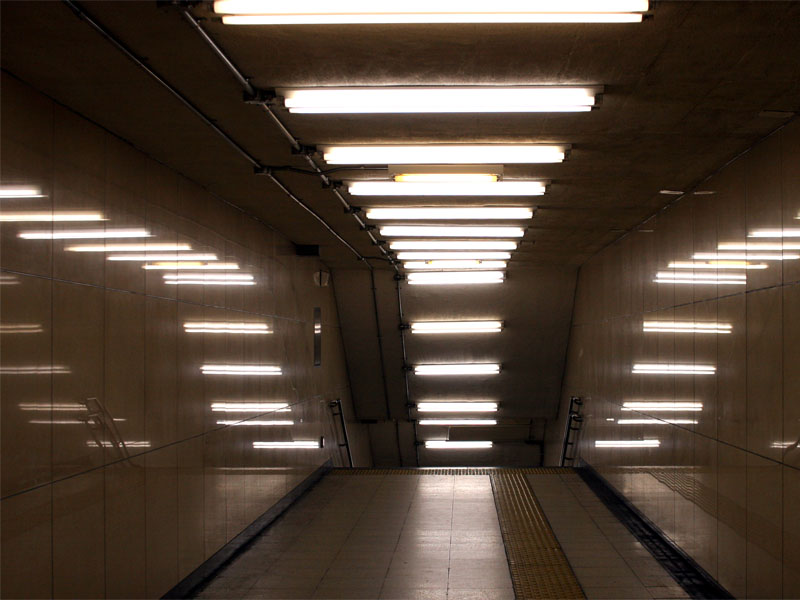
How does a fluorescent/ Tube light work?**
Tube : Filled with Mercury Vapours and inner surface coated with phosphorous.
Choke/Ballast: Inductor to generate High voltage and to maintain arc.
Starter: The small glass tube is filled with neon or argon and contains a bi-metallic plate.
When power is applied to a tube light circuit, this voltage is not sufficient to ionize the gas inside the main tube. To get the lamp started you need a spike of high voltage to get the arc started.
When the starter switch (with the little neon or argon lamp inside) gets warm enough, the bimetallic strip flips the other way, completes the circuit, bypassing the small lamp.
The lamp goes out and the entire circuit shorts. During the short the voltage falls to zero.
The bimetallic strip cools and pops back open, opening the circuit. In the ballast the transformer had a magnetic field, when the circuit is cut the magnetic field collapses and forms an ‘inductive kick’ from the ballast. Suddenly this kick of high voltage is sent through the lamp and this starts the arc.
If it didn’t work, if the lamp is still too cold, then the starter switch will light again and repeat the process.
Current passes through the tungsten electrodes on each end of the lamp. The electrodes are like a filament on an incandescent lamp, when current passes through they heat up and give off free electrons.
This process of letting off free electrons is called thermionic emission.

Why does alcohol make us to behave differently?
Alcohol, or ethanol, is the chemical found in beer, wine and liquor. Alcohol is made by the fermentation of yeast, starch or sugar, including grains like rice and wheat, sugarcane, potatoes, grapes, apples and other fruits.
The enzyme aldehyde dehydrogenase (ALDH), also in the liver and brain, oxidizes the acetaldehyde byproduct into acetic acid.
Disulfiram blocks this oxidation by inhibiting ALDH, causing a rapid rise of acetaldehyde in the blood when alcohol is consumed. When we drink alcohol, it is absorbed into the bloodstream through the stomach and small intestine.
Alcohol impacts the way we act because it is a chemical depressant that slows down the brain and central nervous system.
The depressant effect of alcohol has a big impact on several brain processes. It changes our thinking, judgment, perception, temperature, reaction time, motor/muscle control, vision, hearing, balance, movement, mood and emotions.
It can change the size of the brain and cause psychological disorders to develop. A person can have very unpredictable mood changes and go from happy to sad in a short period of time when drinking. This can cause conflict between people, with fighting and arguing.

The University Grants Commission (UGC) formed in 1945. On 28 December 1953, Maulana Abul Kalam Azad (former Minister of Education) inaugurated University Grants Commission.
It provides financial assistance to eligible colleges which are included under Section 2(f) and declared fit to receive central assistance (UGC grant) under Section 12 (B) of UGC Act, 1956 as per approved pattern of assistance under various schemes.
Note: The Government is planning to replace University Grant Commission (UGC) with a new Higher Education Commission of India (HECI).
BORN TODAY
Mukesh Chand Mathur (22 July 1923 – 27 August 1976), better known mononymously as Mukesh, was an Indian playback singer. Mukesh is considered to be one of the most popular and acclaimed playback singers of the Hindi film industry
Did you know ?
Neem leaves are excellent for your liver, which automatically enhances your digestion. Apart from this, consuming neem on a daily basis also destroys excess bacteria in the intestinal region and cleanses your colon, further facilitating a smoother digestion
If you boil about 20 neem leaves in half a litre of water till the leaves are soft and discoloured, and the water turns green. Strain and store in a bottle. Dip a cotton-ball into it and wipe your face.
Lightens skin blemishes: Apply a paste of neem powder, tulsi and sandalwood powder mixed with rose water, on your face.
Goodbye dandruff : Boil a bunch of neem leaves till the water turns green, allow it to cool. After washing your hair with shampoo, cleanse it with this water.
Neem leaf is used for leprosy, eye disorders, bloody nose, intestinal worms, stomach upset, loss of appetite, skin ulcers, diseases of the heart and blood vessels (cardiovascular disease), fever, diabetes, gum disease (gingivitis), and liver problems.
 |
Ch Narmada Naveen Kumar |






